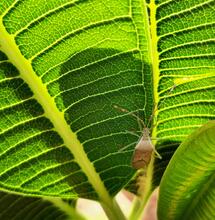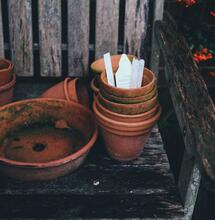CaMg - The Secondary Nutrients

The secondary nutrients—calcium, magnesium, and sulfur—are often grouped with the macronutrients (nitrogen, phosphorus, and potassium) because plants use secondary nutrients in large amounts. Rapid-growing cannabis is able to process more of these nutrients than most general-purpose fertilizers are able to supply. A properly balanced organic or ionic salt hydroponic fertilizer supplies all necessary macro and micro (trace) elements in the proper formulations for maximum results.
Calcium and magnesium are dissolved in all water sources, usually in large amounts. Lower levels of sulfur are also present in most water supplies. Always take into account the amount of preexisting calcium and magnesium ‘nutrients’ already available in the water supply when fertilizing, especially in hydroponic formulas. Excessive calcium causes “hard water,” a condition that limits nutrient uptake. If growing in an acidic potting soil or soilless mix, correct the pH of the growing medium to 5.8 with agricultural lime. Calcium is already incorporated into the peat part of the mix. The proper rate of all lime tends to be three to five kilograms per 1 m3. With a pH below 6.0, incorporating one cup of fine (flour) dolomite lime per gallon of growing medium ensures adequate supplies of calcium and magnesium. Forms of sulfur are found as compounds in most fertilizers.
ME Ch 21 Calcium
Calcium (Ca)—immobile (essential)
About: Calcium is fundamental to cell manufacturing and growth. Calcium is necessary to preserve membrane permeability and cell integrity, which ensure proper flow of nitrogen and sugars. Calcium stimulates enzymes that help build strong cell and root walls. Cannabis must have some calcium at the growing tip of each root. Since calcium has little mobility within the plant, it must be available in the root zone for uptake in order to avoid shortages.
Tap water “hardness” is determined by the amount of dissolved calcium and magnesium salts. High levels of calcium help protect plant tissue from pest and disease attacks. But hard water scale contains a considerable amount of calcium carbonate, CaCO3, which is almost insoluble in water. Deficiency: Calcium is most often deficient in hydroponic gardens, but this deficiency is rather uncommon in greenhouses and indoors. Calcium is abundant in virtually all soils but occasionally lacking outdoors in cool wet climates and acidic soil.
Calcium is sometimes deficient in soilless rooting mediums. Early deficiency causes lower leaves to contort and curl. As the deficiency progresses, symptoms appear relatively quickly, first in lower leaves that develop yellowish-brown irregular spots with a dark brown border that enlarges over time.
Often spots are at or near the edge of leaves. Older affected leaves develop yellowish hazy zones and spots around larger necrotic irregular spots. Flower bud development is inhibited, and root tips often die back. The plants are stunted and harvest is diminished.
Cause: An imbalanced fertilizer with unavailable calcium causes a deficiency. Calcium can be bound or fixed in (acidic) soil and unavailable for uptake. Excess ammonium, magnesium, potassium, and sodium in the root zone impair calcium uptake. Often, calcium is available in solution and growing medium but unavailable within the plant due to a transport problem (within the plant) caused by environmental conditions.
Humidity that is too high or too low impairs transpiration. An EC that is too high, or improper irrigation that causes internal movement of water, will affect calcium uptake and is demonstrated in lower leaves. Excess phosphorus could also be the cause. Confused with: Root disease, excess nitrogen (ammonium), magnesium, potassium and sodium or deficiencies of iron, potassium and zinc.
Solution: Leach soil and soilless mix with plain or low-EC water to wash out any built-up fertilizer salts that impair calcium uptake. Avert deficiencies in the soil and in most soilless mixes by adding fine dolomite lime (Ca and Mg) or gypsum (calcium sulfate hydrate [CaSO4·2(H2O)]) to the planting mix. Acidic soils often contain low levels of calcium. Use properly formulated soluble hydroponic fertilizer that contains adequate available calcium, preferably calcium nitrate.
Dissolve one-half teaspoon (2.5 cc) of hydrated lime per gallon of water. Water the deficient plants with calcium-dosed water as long as new deficiency symptoms persist. Remember, damaged tissue will not go away. Or use a complete hydroponic nutrient that contains adequate available calcium. Keep the pH of the growing medium stable. Reverse osmosis filtered water must have calcium added. Excess: Leaves wilt, but very little.
Excessive amounts of soluble calcium applied early in life can stunt growth. Too much calcium blocks potassium, iron, magnesium, and manganese uptake. If growing hydroponically, an excess of calcium will combine with sulfur in the solution, which causes the nutrient solution to suspend in the water and to aggregate into clumps, which then causes the water to become cloudy (flocculate). Once calcium and sulfur combine, they form a residue [gypsum CaSO4·2(H2O)] that settles to the bottom of the reservoir. Cause: Too much available calcium in water or nutrient solution Confused with: Deficiency of potassium, magnesium, manganese, or iron Solution: Change nutrient solution, attempt to wash excess from soil with heavy leaching.
ME Ch 21 Magnesium
Magnesium (Mg)—mobile (essential)
About: Cannabis uses a lot of magnesium. It is the central atom in every chlorophyll molecule, and it is essential to the absorption of light energy and photosynthesis. It aids in the utilization of nutrients. Magnesium helps enzymes make carbohydrates and sugars that are later transformed into flowers. It also neutralizes the soil acids and toxic compounds produced by the plant. Deficiency: Deficiencies are common indoors and occasionally outdoors, especially in acidic soils. No deficiency symptoms are visible during the first 3 to 4 weeks.
In the fourth to sixth week of growth, the first signs of deficiency appear. Interveinal yellowing and irregular rust-brown spots appear on older and middle-aged leaves and younger leaves remain healthy. Size of rust-brown spots between green veins increases and migrates to lower and finally newer leaves as the deficiency progresses. The entire plant looks sick. Rusty-brown spots appear on the leaf margins, tips, and between the veins. Leaves start dying and dropping, possibly curling before falling off. A minor deficiency will cause few problems with growth.
However, minor deficiencies can quickly escalate during flowering and cause a diminished harvest as flowering progresses. Cause: Magnesium is bound in the soil if there is an excess of potassium, ammonia (nitrogen), and calcium (carbonate). Most often, magnesium is in the soil but unavailable to the plant because the root environment is too acidic, wet and cold. Clay soils rich in calcium also tend to be magnesium poor.
Small root systems are also unable to take in enough magnesium to supply heavy demand. A high EC slows water evaporation and diminishes magnesium availability. Confused with: An excess of potassium, ammoniacal nitrogen, and calcium carbonate Spray with a 2 percent solution of Epsom salts every 4 to 5 days. Solution: Add superfine dolomite lime to acidic potting soils before planting; it will stabilize the pH and add magnesium and calcium to the growing medium. Add 10 cc of Epsom salts (magnesium sulfate) per 3.8 L of water with each watering to correct magnesium deficiencies if no dolomite was added when planting. Or dilute Kieserite (magnesium sulfate monohydrate, MgSO4·H2O) in water.
For fast results spray the foliage with a 2 percent solution of Epsom salts every 4 to 5 days. If the deficiency progresses to the top of the plant, it will turn green there first. In 4 to 6 days, the green-up will start moving down the plant, turning lower leaves progressively greener. Continue a regular watering schedule with Epsom salts until the symptoms totally disappear. Use Epsom salts designed specifically for plants rather than the supermarket type. Another option is to apply Kieserite, found packaged as Ca-Mg fertilizer/ supplement.
Composted cow and turkey manure is also rich in magnesium. Control room and root-zone temperatures, humidity, pH, and EC of the nutrient solution. Keep root zone and nutrient solution at 21.1°C–23.9°C. Keep ambient air temperature at 21.1°C day and 18.3°C night. Use a complete fertilizer with an adequate amount of magnesium. Keep the soil pH above 6.5, the hydroponic pH above 5.5, and reduce high EC for a week. Reduce EC by leaching with plain water. Excess: Excess magnesium is rare and does not appear quickly. Extra magnesium in the soil is in itself generally not harmful, but it inhibits calcium uptake.
Symptoms appear as an overall salt toxicity accompanied by stunted growth and dark-green foliage. Cause: Magnesium toxicity is rare and difficult to discern with the naked eye. If extremely toxic, the magnesium develops a conflict with other fertilizer ions, usually calcium, especially in hydroponic nutrient solutions. Toxic buildup of magnesium is uncommon in soil that is able to grow cannabis.
Confused with: Calcium deficiency Solution: Leach soil heavily to wash out excess. This is an excerpt from chapter 21 “Nutrients” from the Cannabis Encyclopedia (596 pages, 2,000+ color images, large A4 format) by Jorge Cervantes that is available everywhere in English. Spanish edition will be available January 2017. For more information please see Jorge´s website, www.marijuanagrowing.com. Jorge Cervantes



.png)